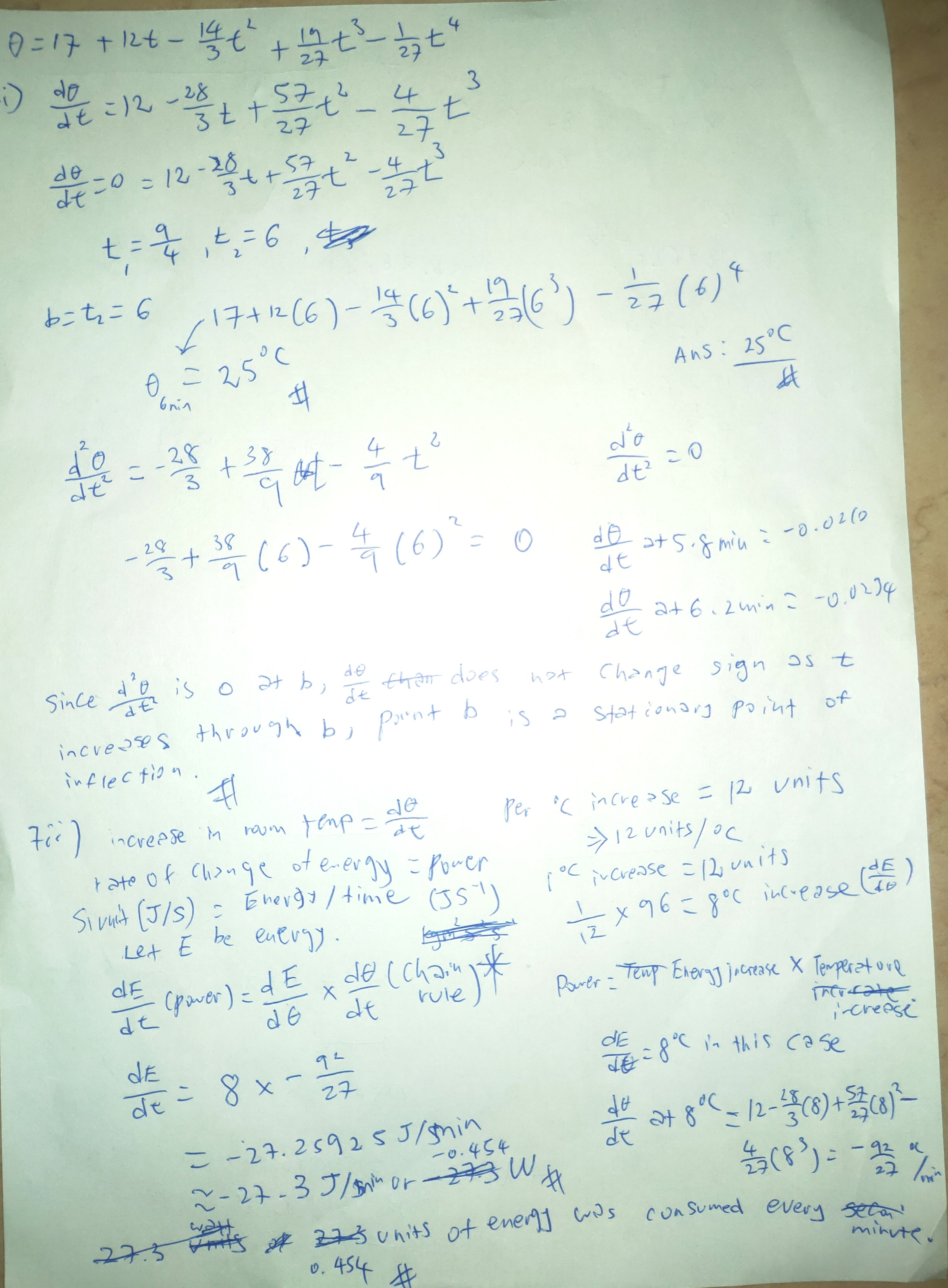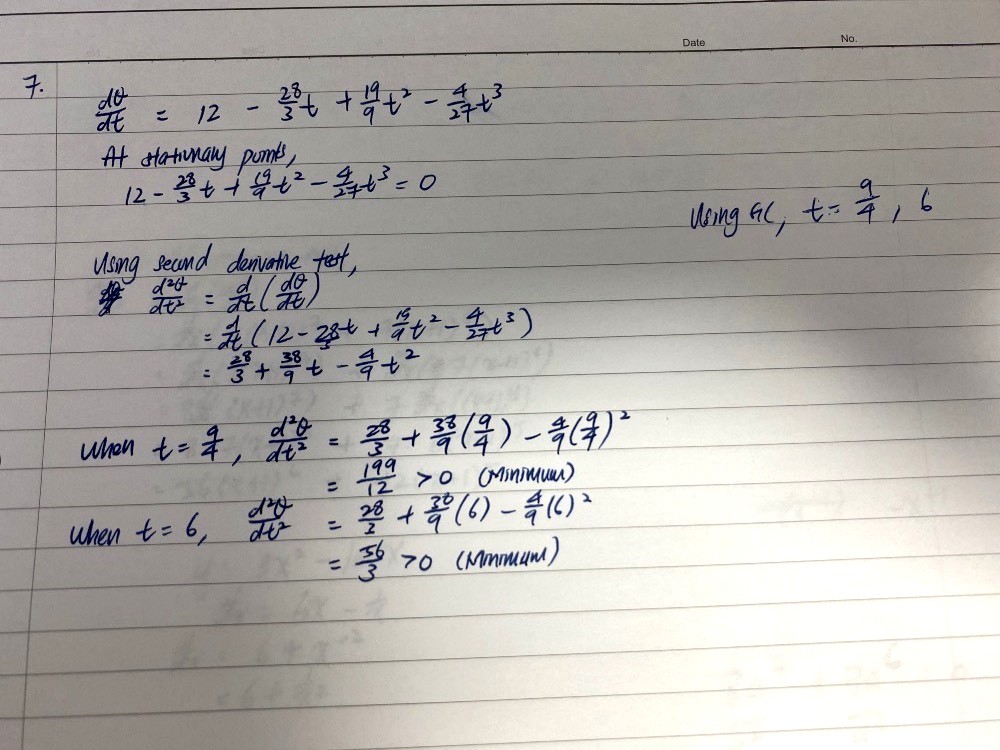Ask Singapore Homework?
Upload a photo of a Singapore homework and someone will email you the solution for free.

See 2 Answers
done
{{ upvoteCount }} Upvotes
clear
{{ downvoteCount * -1 }} Downvotes
For part 7i, find first and second derivative. In other words, differentiate twice. Apply second derivative test to test for nature of turning point. In this case, second derivative is 0 at 6 deg celsius, with no change in sign throughout temperature, it is a point of inflection (not max point or minimum point).
For part 7ii, apply chain rule to find the answer. Note: the time (t) is in minute. You can present your answer in 27.3 units/min or 0.454 units/seconds by doing some conversion. Ignore the J/s and watts as that was some error in doing lol. Use units/min instead. Hope it helps!
For part 7ii, apply chain rule to find the answer. Note: the time (t) is in minute. You can present your answer in 27.3 units/min or 0.454 units/seconds by doing some conversion. Ignore the J/s and watts as that was some error in doing lol. Use units/min instead. Hope it helps!
Date Posted:
4 years ago
For part(i), how did you get t=9/4 and t=6?
If I apply second derivative,
I get 28/3 + 38/9t - 4/9t^2
Then how do I solve it from here?
If I apply second derivative,
I get 28/3 + 38/9t - 4/9t^2
Then how do I solve it from here?
For part i, you can apply factor theorem to solve the cubic equation or calculator.
After you have applied second derivative, substitute t=6 into it and see if it is positive, negative or zero. In this case, it is 0.
So 9/4 and 6 is the value of a and b on the graph respectively?
Is it possible to find the value c with the i formation provided?
QN, this is an example of d²y/dx² = 0 does not necessarily imply it's a inflection point.
Even though from the graph it looks like inflection point at x = b, you still have to use first derivative test to verify it.
It's similar to angles questions where an angle may look like 90° but you'll have to calculate to see if its actually 90° or not
Even though from the graph it looks like inflection point at x = b, you still have to use first derivative test to verify it.
It's similar to angles questions where an angle may look like 90° but you'll have to calculate to see if its actually 90° or not
From the graph, the two dotted lines from θ = 17 and t = c meet at the end of the graph.
This already tells you that θ = 17 when t = c
Solve for θ = 17 to find c
This already tells you that θ = 17 when t = c
Solve for θ = 17 to find c
Oh ok thanks!
For part(ii), the answer key is 55 5/9.
Why do we multiply t=8 in dθ/dt ?
dE/dt = dE/dθ x dθ/dt
Then from the qn dE/dθ is 12 units?
And dθ/dt is 12 - 28/3t + 19/9t^2 - 4/27t^3
So should I just multiply (12) to (12 - 28/3t +
19/9t^2 - 4/27t^3)
[dE/dθ x dθ/dt]
Why do we multiply t=8 in dθ/dt ?
dE/dt = dE/dθ x dθ/dt
Then from the qn dE/dθ is 12 units?
And dθ/dt is 12 - 28/3t + 19/9t^2 - 4/27t^3
So should I just multiply (12) to (12 - 28/3t +
19/9t^2 - 4/27t^3)
[dE/dθ x dθ/dt]
There seems to be a mistake in Ignatius's working.
dE/dθ is a constant of 12 units per °C
(i.e 12 units increase in energy per 1 °C increase in temperature)
96 units ÷ 12 units/°C = 8°C
This means the temperature increased by 8°C, not time = 8 min.
Since the room temperature = 17°C at t = 0, (where the heater is just turned on and no energy is used yet)
Current temperature the room is at when 96 units of energy have been used
= 17°C + 8°C = 25°C
When θ = 25, t = 1 or t = 6
(I'm sure you can solve for this so I won't provide working)
When t = 1, dθ/dt = 125/27
dE/dt = dE/dθ x dθ/dt
= 12 x 125/27
= 650/9
55 5/9
dE/dθ is a constant of 12 units per °C
(i.e 12 units increase in energy per 1 °C increase in temperature)
96 units ÷ 12 units/°C = 8°C
This means the temperature increased by 8°C, not time = 8 min.
Since the room temperature = 17°C at t = 0, (where the heater is just turned on and no energy is used yet)
Current temperature the room is at when 96 units of energy have been used
= 17°C + 8°C = 25°C
When θ = 25, t = 1 or t = 6
(I'm sure you can solve for this so I won't provide working)
When t = 1, dθ/dt = 125/27
dE/dt = dE/dθ x dθ/dt
= 12 x 125/27
= 650/9
55 5/9
We use t = 1 because we are only concerned with the accumulative energy used from the start to when the temperature first reaches 25°C.
At t = 0, the heater has just been switched on and no energy is used yet.
Temperature then rises from 17°C at t = 0 to 25°C at t = 1, and 96 units of energy have been used. This is an increase of 8°C.
Beyond t = 1, the temperature has continued to rise and then reached maximum at t = 9/4 .
Now, the heater was probably turned off at this point. So the temperature decreased, until t = 6, where the temperature reached the stationary point of inflection of 25°C (where the rate of decrease is now 0 i.e dθ/dt = 0)
But we cannot use t = 6 as that would be a point of time where the total energy used by the heater has already exceeded 96 units (it was still heating from t = 1 to t = 9/4, meaning more energy was used)
At t = 0, the heater has just been switched on and no energy is used yet.
Temperature then rises from 17°C at t = 0 to 25°C at t = 1, and 96 units of energy have been used. This is an increase of 8°C.
Beyond t = 1, the temperature has continued to rise and then reached maximum at t = 9/4 .
Now, the heater was probably turned off at this point. So the temperature decreased, until t = 6, where the temperature reached the stationary point of inflection of 25°C (where the rate of decrease is now 0 i.e dθ/dt = 0)
But we cannot use t = 6 as that would be a point of time where the total energy used by the heater has already exceeded 96 units (it was still heating from t = 1 to t = 9/4, meaning more energy was used)
I made some mistake in the working for part 7ii. What I meant for part 7i's statement is if d^2y/dx^2 =0 and using first derivative test to observe for sign change, if these two conditions have been fulfilled, then it's a point of inflection. I did not explicitly point out when d^2y/dx^2 is 0 is inconclusive. Second derivative test doesn't tell you anything about inflection point, but point of inflection occurs when f''(x)=0. When f"(x)=0, first derivative test must be done to determine whether it is an inflection point.
For part 7ii, dE/dtheta is 12units/oc and not 8 as mentioned in the working. Yea sub in t =1 to find out dtheta/dt. Didn't know why I wrote this just now lol gg. Sorry for the mistake. Anyway I did your qn for fun after drinking some.... So yea...
For part 7ii, dE/dtheta is 12units/oc and not 8 as mentioned in the working. Yea sub in t =1 to find out dtheta/dt. Didn't know why I wrote this just now lol gg. Sorry for the mistake. Anyway I did your qn for fun after drinking some.... So yea...
Is there a way to find t=1 and t=6 without using the GC?
Haha thanks for helping anyway
Yes
dθ/dt = 12 - 28/3 t + 19/9 t² - 4/27 t³
When dθ/dt = 0,
12 - 28/3 t + 19/9 t² - 4/27 t³ = 0
Multiply by 27,
324 - 252t + 57t² - 4t³ = 0
Either bring terms over to other side, (or multiply both sides if equation by -1)
4t³ - 57t² + 252t - 324 = 0
When t = 6,
4t³ - 57t² + 252t - 324
= 4(6)³ - 57(6)² + 252(6) - 324
= 864 - 2052 + 1512 - 324
= 0
By the factor theorem, (t - 6) is a factor of
4t³ - 57t² + 252t - 324 = 0
(t - 6)(4t² - 33t + 54) = 0
(You can do your usual factorisation by trial and error, or compare coefficients)
(t - 6)(4t - 9)(t - 6) = 0
(Upon further factorisation , we realise that (t - 6) is a repeated factor. So t = 6 is a repeated root)
(t - 6)²(4t - 9) = 0
(t - 6)² = 0 or 4t - 9 = 0
t - 6 = 0 or 4t = 9
t = 6 or t = 9/4 = 2¼
When dθ/dt = 0,
12 - 28/3 t + 19/9 t² - 4/27 t³ = 0
Multiply by 27,
324 - 252t + 57t² - 4t³ = 0
Either bring terms over to other side, (or multiply both sides if equation by -1)
4t³ - 57t² + 252t - 324 = 0
When t = 6,
4t³ - 57t² + 252t - 324
= 4(6)³ - 57(6)² + 252(6) - 324
= 864 - 2052 + 1512 - 324
= 0
By the factor theorem, (t - 6) is a factor of
4t³ - 57t² + 252t - 324 = 0
(t - 6)(4t² - 33t + 54) = 0
(You can do your usual factorisation by trial and error, or compare coefficients)
(t - 6)(4t - 9)(t - 6) = 0
(Upon further factorisation , we realise that (t - 6) is a repeated factor. So t = 6 is a repeated root)
(t - 6)²(4t - 9) = 0
(t - 6)² = 0 or 4t - 9 = 0
t - 6 = 0 or 4t = 9
t = 6 or t = 9/4 = 2¼
But we might as well use GC since we'll get the same marks awarded. Saves time and the effort to write out all the working.
If you use factor theorem, you'll also need to guess the root correctly. We won't know right at the start that t = 6 would be a root.
If required to show factor theorem or if question says 'without use of GC', you can still use the GC to find the roots first.
Then use the appropriate values for your factor theorem working. In a sense we merely didn't indicate that GC was used and it would appear as if we trialled t = 6 correctly
If you use factor theorem, you'll also need to guess the root correctly. We won't know right at the start that t = 6 would be a root.
If required to show factor theorem or if question says 'without use of GC', you can still use the GC to find the roots first.
Then use the appropriate values for your factor theorem working. In a sense we merely didn't indicate that GC was used and it would appear as if we trialled t = 6 correctly
Thanks!!
done
{{ upvoteCount }} Upvotes
clear
{{ downvoteCount * -1 }} Downvotes

t=9/4 and t=6
When 2nd derivative > 0
When 2nd derivative > 0
Date Posted:
4 years ago
It should be -28/3 (you forgot the -)
You should be getting d²θ/dt² = -25/12 for t = 9/4 and d²θ/dt² = 0 for t = 6
Oh haha
So when I get zero when t=6, do I say
d^2θ/dt^2 = 0 (Invalid)
And proceed to do first derivative?
So when I get zero when t=6, do I say
d^2θ/dt^2 = 0 (Invalid)
And proceed to do first derivative?
You can write (inconclusive)
Then do first derivative test.
Then do first derivative test.
Ok thanks!





